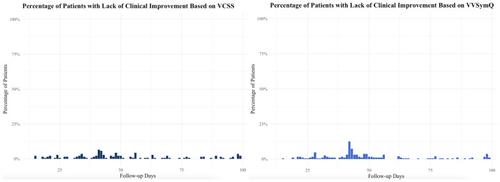当前位置:
X-MOL 学术
›
J. Vasc. Surg. Venous Lymphatic Disord.
›
论文详情
Our official English website, www.x-mol.net, welcomes your feedback! (Note: you will need to create a separate account there.)
Factors associated with lack of clinical improvement after vein ablation in the vascular quality initiative
Journal of Vascular Surgery: Venous and Lymphatic Disorders ( IF 3.2 ) Pub Date : 2024-03-27 , DOI: 10.1016/j.jvsv.2024.101884 Paula Pinto Rodríguez , Michael Fassler , Andrea Obi , Nicholas H. Osborne , Scott T. Robinson , Benjamin N. Jacobs , Faisal Aziz , Khanh P. Nguyen , Adam M. Gwozdz , Limael E. Rodriguez , Eri Fukaya , Ulka Sachdev , Cassius Iyad Ochoa Chaar
Journal of Vascular Surgery: Venous and Lymphatic Disorders ( IF 3.2 ) Pub Date : 2024-03-27 , DOI: 10.1016/j.jvsv.2024.101884 Paula Pinto Rodríguez , Michael Fassler , Andrea Obi , Nicholas H. Osborne , Scott T. Robinson , Benjamin N. Jacobs , Faisal Aziz , Khanh P. Nguyen , Adam M. Gwozdz , Limael E. Rodriguez , Eri Fukaya , Ulka Sachdev , Cassius Iyad Ochoa Chaar

|
Insurance companies have adopted variable and inconsistent approval criteria for chronic venous disease (CVD) treatment. Although vein ablation (VA) is accepted as the standard of care for venous ulcers, the treatment criteria for patients with milder forms of CVD remain controversial. This study aims to identify factors associated with a lack of clinical improvement (LCI) in patients with less severe CVD without ulceration undergoing VA to improve patient selection for treatment. We performed a retrospective analysis of patients undergoing VA for CEAP C2 to C4 disease in the Vascular Quality Initiative varicose veins database from 2014 to 2023. Patients who required intervention in multiple veins, had undergone prior interventions, or presented with CEAP C5 to C6 disease were excluded. The difference (Δ) in venous clinical severity score (VCSS; VCSS before minus after the procedure) was used to categorize the patients. Patients with a ΔVCSS of ≤0 were defined as having LCI after VA, and patients with ≥1 point decrease in the VCSS after VA (ΔVCSS ≥1) as having some benefit from the procedure and, therefore, “clinical improvement.” The characteristics of both groups were compared, and multivariable regression analysis was performed to identify factors independently associated with LCI. A second analysis was performed based on the VVSymQ instrument, which measures patient-reported outcomes using five specific symptoms (ie, heaviness, achiness, swelling, throbbing pain, and itching). Patients with LCI showed no improvement in any of the five symptoms, and those with clinical improvement had a decrease in severity of at least one symptom. A total of 3544 patients underwent initial treatment of CVD with a single VA. Of the 3544 patients, 2607 had VCSSs available before and after VA, and 420 (16.1%) had LCI based on the ΔVCSS. Patients with LCI were more likely to be significantly older and African American and have CEAP C2 disease compared with patients with clinical improvement. Patients with clinical improvement were more likely to have reported using compression stockings before treatment. The vein diameters were not different between the two groups. The incidence of complications was overall low, with minor differences between the two groups. However, the patients with LCI were significantly more likely to have symptoms after intervention than those with improvement. Patients with LCI were more likely to have technical failure, defined as vein recanalization. On multivariable regression, age (odds ratio [OR], 1.01; 95% confidence interval [CI], 1.00-1.02) and obesity (OR, 1.47; 95% CI, 1.09-2.00) were independently associated with LCI, as was treatment of less severe disease (CEAP C2; OR, 1.82; 95% CI, 1.30-2.56) compared with more advanced disease (C4). The lack of compression therapy before intervention was also associated with LCI (OR, 6.05; 95% CI, 4.30-8.56). The analysis based on the VVSymQ showed similar results. LCI after VA is associated with treating patients with a lower CEAP class (C2 vs C4) and a lack of compression therapy before intervention. Importantly, no significant association between vein size and clinical improvement was observed.
中文翻译:

血管质量倡议中静脉消融后临床缺乏改善的相关因素
保险公司对慢性静脉疾病(CVD)治疗采用了可变且不一致的批准标准。尽管静脉消融 (VA) 被认为是静脉溃疡的治疗标准,但轻度 CVD 患者的治疗标准仍存在争议。本研究旨在确定与接受 VA 治疗的不太严重 CVD 且无溃疡的患者缺乏临床改善 (LCI) 相关的因素,以改善患者的治疗选择。我们对 2014 年至 2023 年血管质量倡议静脉曲张数据库中因 CEAP C2 至 C4 疾病接受 VA 的患者进行了回顾性分析。需要多条静脉干预、之前接受过干预或出现 CEAP C5 至 C6 疾病的患者为排除。静脉临床严重程度评分(VCSS;手术前减去术后VCSS)的差异(Δ)用于对患者进行分类。 ΔVCSS ≤ 0 的患者被定义为 VA 后出现 LCI,VA 后 VCSS 降低 ≥1 分(ΔVCSS ≥1)的患者被定义为从手术中获益,因此“临床改善”。比较两组的特征,并进行多变量回归分析以确定与 LCI 独立相关的因素。第二次分析是基于 VVSymQ 仪器进行的,该仪器使用五种特定症状(即沉重、疼痛、肿胀、搏动性疼痛和瘙痒)来测量患者报告的结果。 LCI 患者的五种症状中的任何一种都没有改善,而临床改善的患者至少有一种症状的严重程度有所下降。共有 3544 名患者接受了单次 VA 的 CVD 初步治疗。在 3544 名患者中,2607 名患者在 VA 前后具有可用的 VCSS,420 名患者 (16.1%) 具有基于 ΔVCSS 的 LCI。与临床改善的患者相比,LCI 患者年龄更大、为非裔美国人且患有 CEAP C2 疾病的可能性更大。临床改善的患者更有可能在治疗前报告使用压力袜。两组之间的静脉直径没有差异。并发症的发生率总体较低,两组之间差异较小。然而,与改善的患者相比,LCI 患者在干预后出现症状的可能性明显更大。 LCI 患者更有可能出现技术故障,即静脉再通。在多变量回归中,年龄(比值比 [OR],1.01;95% 置信区间 [CI],1.00-1.02)和肥胖(OR,1.47;95% CI,1.09-2.00)与 LCI 独立相关,治疗也是如此与较严重的疾病 (C4) 相比,较轻的疾病 (CEAP C2;OR,1.82;95% CI,1.30-2.56) 更严重。干预前缺乏压力治疗也与 LCI 相关(OR,6.05;95% CI,4.30-8.56)。基于 VVSymQ 的分析显示了类似的结果。VA 后的 LCI 与治疗 CEAP 等级较低(C2 与 C4)的患者以及干预前缺乏压力治疗有关。重要的是,没有观察到静脉大小和临床改善之间存在显着关联。
更新日期:2024-03-27
中文翻译:

血管质量倡议中静脉消融后临床缺乏改善的相关因素
保险公司对慢性静脉疾病(CVD)治疗采用了可变且不一致的批准标准。尽管静脉消融 (VA) 被认为是静脉溃疡的治疗标准,但轻度 CVD 患者的治疗标准仍存在争议。本研究旨在确定与接受 VA 治疗的不太严重 CVD 且无溃疡的患者缺乏临床改善 (LCI) 相关的因素,以改善患者的治疗选择。我们对 2014 年至 2023 年血管质量倡议静脉曲张数据库中因 CEAP C2 至 C4 疾病接受 VA 的患者进行了回顾性分析。需要多条静脉干预、之前接受过干预或出现 CEAP C5 至 C6 疾病的患者为排除。静脉临床严重程度评分(VCSS;手术前减去术后VCSS)的差异(Δ)用于对患者进行分类。 ΔVCSS ≤ 0 的患者被定义为 VA 后出现 LCI,VA 后 VCSS 降低 ≥1 分(ΔVCSS ≥1)的患者被定义为从手术中获益,因此“临床改善”。比较两组的特征,并进行多变量回归分析以确定与 LCI 独立相关的因素。第二次分析是基于 VVSymQ 仪器进行的,该仪器使用五种特定症状(即沉重、疼痛、肿胀、搏动性疼痛和瘙痒)来测量患者报告的结果。 LCI 患者的五种症状中的任何一种都没有改善,而临床改善的患者至少有一种症状的严重程度有所下降。共有 3544 名患者接受了单次 VA 的 CVD 初步治疗。在 3544 名患者中,2607 名患者在 VA 前后具有可用的 VCSS,420 名患者 (16.1%) 具有基于 ΔVCSS 的 LCI。与临床改善的患者相比,LCI 患者年龄更大、为非裔美国人且患有 CEAP C2 疾病的可能性更大。临床改善的患者更有可能在治疗前报告使用压力袜。两组之间的静脉直径没有差异。并发症的发生率总体较低,两组之间差异较小。然而,与改善的患者相比,LCI 患者在干预后出现症状的可能性明显更大。 LCI 患者更有可能出现技术故障,即静脉再通。在多变量回归中,年龄(比值比 [OR],1.01;95% 置信区间 [CI],1.00-1.02)和肥胖(OR,1.47;95% CI,1.09-2.00)与 LCI 独立相关,治疗也是如此与较严重的疾病 (C4) 相比,较轻的疾病 (CEAP C2;OR,1.82;95% CI,1.30-2.56) 更严重。干预前缺乏压力治疗也与 LCI 相关(OR,6.05;95% CI,4.30-8.56)。基于 VVSymQ 的分析显示了类似的结果。VA 后的 LCI 与治疗 CEAP 等级较低(C2 与 C4)的患者以及干预前缺乏压力治疗有关。重要的是,没有观察到静脉大小和临床改善之间存在显着关联。



























 京公网安备 11010802027423号
京公网安备 11010802027423号